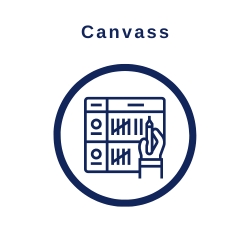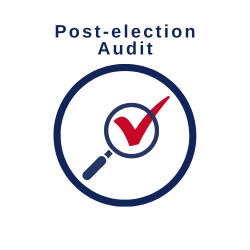
Have you ever wondered what happens to your ballot after you get your I Voted Sticker? After the polls close, ballots and electronic vote records are securely transferred to the elections office. Election officials make election results public as quickly as possible. However, even when those results say “100% Precincts Reporting,” they are still unofficial.
The process of reporting, canvassing, and certifying election results takes a great deal of work. This page contains information about how election results change from unofficial to official as well as best practices and resources to help election officials communicate this essential process to voters. While detailed information about post-election audit processes is not included here, more information about audits can be found in the EAC report Election Audits Across the United States.
Additionally, election officials can use the Communicating Election and Post-Election Processes Toolkit to create educational materials about pre- and post-election processes that observers and the public can understand. Election officials in any size jurisdiction can adapt this toolkit to fit their observer and voter education needs.
The election results reported on election night are never the final, certified results. Election officials well know there are various other steps and factors that impact when election results are final. Communicating that information with the public can be a challenge. Voters look to election officials for trusted information about election results. How election officials display election results can play a key role in facilitating public confidence in election outcomes.
Election officials can use the Checklist for Securing Election Night Results Reporting as a baseline to assess their current Election Night Reporting cybersecurity protocols. These protocols would be in addition to other physical and administrative procedures election officials implement to ensure data reliability, including documented chain of custody, data verification procedures, and using certified technology to tabulate vote totals.
Checklist for Securing Election Night Results Reporting
To help communicate the nuances of this process,the resources below help provide context when voters are viewing election results online.
Best Practices: Election Results Reporting


Leading up to the 2020 general election, the EAC hosted a discussion on preparing for election night reporting and press coverage on election results. Speakers offered remarks on issues surrounding misinformation and disinformation, unofficial results, managing expectations, ballots received after the election, and audits. Joining the EAC Commissioners were New Mexico Secretary of State Maggie Toulouse Oliver, Iowa Secretary of State Paul Pate; Brian Carovillano, Vice President and Managing Editor of the Associated Press; and Nate Persily, Professor of Law, Stanford Law School. Watch a recording of the event below.
The canvass is a culmination of all the data generated during an election cycle. More importantly, it is a process that allows election officials to confirm the accuracy of election data and identify areas for improvement. The canvass process aggregates and confirms every valid ballot cast and counted, including mail, uniformed and overseas citizen, early voting, Election Day, and provisional ballots.
Election officials can find information about the canvass process in the best practices guide below, Guide to the Canvass. This document includes best practices for conducting post-election canvasses, including checklists for key parts of the canvass.
Voters may have questions about the canvass process, and how this process ensures that election results are both secure and accurate. The resources below are intended to help election officials explain this process to their voters.
Election Certification
Election certification refers to the process of election officials attesting that the election results are a true and accurate accounting of all votes cast in a particular election.
Importantly, the results reported on election night are not final even though the media may call the projected winner of races. Only election officials provide official election results. There are several steps election officials complete before they certify final election results. The figure below outlines the typical processes election officials perform before final, official results are certified. Not all jurisdictions follow each procedure outlined, or they may conduct them in a different order.
| Unofficial results are published after the polls close on election night and continue to be released until all ballots are counted. Election results are unofficial until they are certified. | During the canvass, election officials reconcile the number of mail, early, and election day ballots cast with the number of voters. The purpose of the canvass is to make sure that every valid vote is included in the final results. | Most states require a post-election audit to verify voting equipment used during an election correctly counted votes. The timing and method of post-election audits differ among states. | Election officials issue a written statement of certification attesting that the election results are a true and accurate accounting of all votes cast in a particular election. |
Impact of Recounts
In addition to the steps included above, recounts may impact the timeline for final election certification depending on state law. For example, New Hampshire law specifies that state certification takes place after the deadline for a recount has expired. Similarly, in West Virginia, counties must certify results within 30 days of the election or, if there is a recount, within 30 days of completing the recount.
A recount typically includes an additional count of votes cast to make sure the ballots were counted accurately. Each state has its own laws regarding the process for initiating a recount. Typically, recounts are initiated in one of the following ways:
- A candidate for office requests a recount
- A voter who participated in the election requests a recount
- The vote margin falls within a legally required recount threshold
- A judge issues a court order to recount a contest
For requested recounts, state law may require the requestor to pay a set fee or the cost of the recount. Although no federal uniform statutory timeline exists for recounts, any recount would need to be resolved before statutory deadlines for transmission of certificates of ascertainment containing the names of the presidential electors and other candidates taking office.
Who certifies election results and when?
When polls close, local election officials will report unofficial election results to the public and if it is a state or federal election to their respective states. State election offices will aggregate data and report unofficial results for State and Federal offices, including President and Vice President. Then, after every valid vote has been included in the final results, and all required processes have been completed, the election results will be certified.
Certification of election results at both the local and state level varies between states and sometimes even between local jurisdictions within a state depending on the contest being certified. Localities may have a multi-member board or a single elected election official, like a county auditor or municipal clerk, who certify results. At the state level, results may be certified by a single elected official (for example the Secretary of State or Governor), the state legislative body, an appointed election director, or by a multi-member board. Certifying a presidential election involves an additional set of deadlines and players—namely, electors. When voters cast their votes for President and Vice President, they are choosing a slate of electors to send to the Electoral College. Several states have a different timeline for the certification of the presidential race versus other Federal offices due to deadlines associated with the Electoral College.
The following table provides an estimated certification timeline for each state’s local and state election officials to certify the 2024 general election results for federal offices. Estimated dates are for general informational purposes only. In the event a jurisdiction must recount a contest, it may impact the certification deadline. State and local election officials are the authorities on election certification dates.
| Jurisdiction | Local Certification Deadline |
State Certification Deadline |
Notes |
|---|---|---|---|
| Alabama | November 15 | November 27 | |
| Alaska | November 30 | State deadline is the target deadline of the Alaska Division of Elections |
|
| Arizona | November 21 | December 2 | State deadline is the deadline to issue certificates. November 25 is the state canvass deadline. |
| Arkansas | November 13 (presidential electors) November 20 (other federal offices) |
November 30 (presidential electors) December 20 (other federal offices) |
|
| California | December 5 | December 7 (presidential electors) December 13 (other federal offices) |
|
| Colorado | November 27 | December 2 | |
| Connecticut | November 8 | November 27 | |
| Delaware | November 7 | November 7 | |
| District of Columbia |
December 2 | Tentative deadline | |
| Florida | November 18 | November 19 | |
| Georgia | November 12 | November 22 (other federal offices) November 23 (presidential electors) |
|
| Hawaii | November 25 | November 25 (other federal offices) November 30 (presidential electors) |
|
| Idaho | November 15 | November 26 | |
| Illinois | November 26 | December 6 | |
| Indiana | November 18 | November 18 (other federal offices) November 26 (presidential electors) |
State deadlines for Election Division to tabulate results |
| Iowa | November 18 | December 2 | |
| Kansas | November 19 | December 2 | State deadline for State Board of Canvassers to meet |
| Kentucky | November 8 | November 25 | |
| Louisiana | November 11 | November 21 | State final results publication date. |
| Maine | November 7 | November 25 | |
| Maryland | November 15 | December 5 | |
| Massachusetts | November 20 | November 30 | |
| Michigan | November 19 | November 25 | Michigan law permits an expedited canvass if unofficial returns show presidential results are within 25,000 votes |
| Minnesota | November 13 | November 21 | State deadline for state canvass to begin |
| Mississippi | November 15 | December 6 | |
| Missouri | November 15 | November 20 (presidential electors) December 10 (other federal offices) |
|
| Montana | November 19 | November 26 | |
| Nebraska | November 25 | December 2 | |
| Nevada | November 15 | November 26 | |
| New Hampshire |
November 6 | December 4 | State deadline is the date the Governor will issue certificates of election. |
| New Jersey | November 25 | December 5 | |
| New Mexico | November 15 (counties with fewer than 150,000 voters) November 18 (counties with over 150,000 voters) |
November 26 | State deadline to declare results with certificates issued by December 6 |
| New York | November 30 | December 9 | |
| North Carolina | November 15 | November 26 | State certification meeting date |
| North Dakota | November 18 | November 22 | |
| Ohio | November 26 | December 6 | Local certification is expected to be complete by November 20 per Ohio Secretary of State directive. |
| Oklahoma | November 8 | November 12 | |
| Oregon | November 25 | December 12 | State deadline to issue Certificates of Ascertainment is December 11 |
| Pennsylvania | November 25 | Not Specified | |
| Rhode Island | Not Specified | Not Specified | |
| South Carolina | November 8 | November 14 | |
| South Dakota | November 11 | November 12 | State deadline for state canvassers to meet |
| Tennessee | November 25 | November 25 | |
| Texas | November 19 | December 8 | |
| Utah | November 19 | November 25 | State deadline for state canvassers to meet |
| Vermont | November 7 | November 12 | State deadline for state canvassers to meet |
| Virginia | November 15 | December 2 | |
| Washington | November 26 | December 5 | |
| West Virginia | December 5 | December 5 | |
| Wisconsin | November 19 | December 1 | |
| Wyoming | November 8 | November 13 |
California
Yolo County
Harnessing Technology to Improve Polling Place Resources and Response Time, Strengthen Voter Communications, and Increase Future Turnout which has streamlined election night reporting and improve voter participation.
In 2018, the county harnessed GIS Systems and Mapping, along with a new poll worker app, to streamline election night reporting and improve voter participation. The Elections Office partnered with the county’s Information Technology division of the General Services Department to attain several innovative successes. The effort resulted in improved resource allocation, greater response time to polling places, strengthened communication of election results to citizens, and the likelihood of increasing future turnout through targeted outreach and education.
North Carolina
Durham County
Wait-Time Tracker for Early Voting
This innovative app allowed voters to locate polling places closest to them, view voting information, and see current polling place wait times. Users could also find bus routes or get GPS directions. The results from using this application were extremely positive for both election workers and voters. In the 2020 General Election, over 48% of registered voters in Durham County chose to vote early. This new service helped to alleviate crowds at busy polling places by offering alternatives, provided voters with streamlined real-time information, and fostered staffing needs for early in-person locations.
Utah
Utah County
GIS Solutions
The Elections Division and GIS Department in Utah County collaborated on the use of GIS software to improve ballot security, public accountability, office efficiency, and real-time reporting and technology. Three major solutions were developed: a public-facing election results map, a secure dropbox ballot tracker dashboard, and a public-facing real-time ballot workflow dashboard system. These efforts accelerated the ballot counting process, increased security of dropbox information, provided data analysis to improve future elections, and reduced bottom-line costs.









